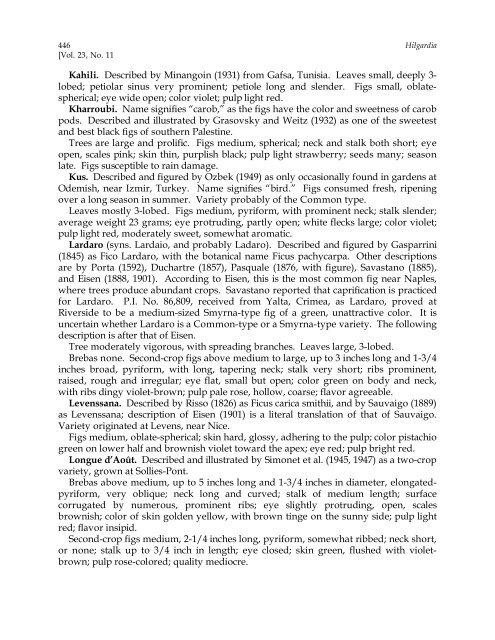Fig Varieties: A Monograph - uri=ucce.ucdavis
Fig Varieties: A Monograph - uri=ucce.ucdavis
Fig Varieties: A Monograph - uri=ucce.ucdavis
Create successful ePaper yourself
Turn your PDF publications into a flip-book with our unique Google optimized e-Paper software.
446 Hilgardia<br />
[Vol. 23, No. 11<br />
Kahili. Described by Minangoin (1931) from Gafsa, Tunisia. Leaves small, deeply 3-<br />
lobed; petiolar sinus very prominent; petiole long and slender. <strong>Fig</strong>s small, oblatespherical;<br />
eye wide open; color violet; pulp light red.<br />
Kharroubi. Name signifies “carob,” as the figs have the color and sweetness of carob<br />
pods. Described and illustrated by Grasovsky and Weitz (1932) as one of the sweetest<br />
and best black figs of southern Palestine.<br />
Trees are large and prolific. <strong>Fig</strong>s medium, spherical; neck and stalk both short; eye<br />
open, scales pink; skin thin, purplish black; pulp light strawberry; seeds many; season<br />
late. <strong>Fig</strong>s susceptible to rain damage.<br />
Kus. Described and figured by Ozbek (1949) as only occasionally found in gardens at<br />
Odemish, near Izmir, Turkey. Name signifies “bird.” <strong>Fig</strong>s consumed fresh, ripening<br />
over a long season in summer. Variety probably of the Common type.<br />
Leaves mostly 3-lobed. <strong>Fig</strong>s medium, pyriform, with prominent neck; stalk slender;<br />
average weight 23 grams; eye protruding, partly open; white flecks large; color violet;<br />
pulp light red, moderately sweet, somewhat aromatic.<br />
Lardaro (syns. Lardaio, and probably Ladaro). Described and figured by Gasparrini<br />
(1845) as Fico Lardaro, with the botanical name Ficus pachycarpa. Other descriptions<br />
are by Porta (1592), Duchartre (1857), Pasquale (1876, with figure), Savastano (1885),<br />
and Eisen (1888, 1901). According to Eisen, this is the most common fig near Naples,<br />
where trees produce abundant crops. Savastano reported that caprification is practiced<br />
for Lardaro. P.I. No. 86,809, received from Yalta, Crimea, as Lardaro, proved at<br />
Riverside to be a medium-sized Smyrna-type fig of a green, unattractive color. It is<br />
uncertain whether Lardaro is a Common-type or a Smyrna-type variety. The following<br />
description is after that of Eisen.<br />
Tree moderately vigorous, with spreading branches. Leaves large, 3-lobed.<br />
Brebas none. Second-crop figs above medium to large, up to 3 inches long and 1-3/4<br />
inches broad, pyriform, with long, tapering neck; stalk very short; ribs prominent,<br />
raised, rough and irregular; eye flat, small but open; color green on body and neck,<br />
with ribs dingy violet-brown; pulp pale rose, hollow, coarse; flavor agreeable.<br />
Levenssana. Described by Risso (1826) as Ficus carica smithii, and by Sauvaigo (1889)<br />
as Levenssana; description of Eisen (1901) is a literal translation of that of Sauvaigo.<br />
Variety originated at Levens, near Nice.<br />
<strong>Fig</strong>s medium, oblate-spherical; skin hard, glossy, adhering to the pulp; color pistachio<br />
green on lower half and brownish violet toward the apex; eye red; pulp bright red.<br />
Longue d’Août. Described and illustrated by Simonet et al. (1945, 1947) as a two-crop<br />
variety, grown at Sollies-Pont.<br />
Brebas above medium, up to 5 inches long and 1-3/4 inches in diameter, elongatedpyriform,<br />
very oblique; neck long and curved; stalk of medium length; surface<br />
corrugated by numerous, prominent ribs; eye slightly protruding, open, scales<br />
brownish; color of skin golden yellow, with brown tinge on the sunny side; pulp light<br />
red; flavor insipid.<br />
Second-crop figs medium, 2-1/4 inches long, pyriform, somewhat ribbed; neck short,<br />
or none; stalk up to 3/4 inch in length; eye closed; skin green, flushed with violetbrown;<br />
pulp rose-colored; quality mediocre.
















![Fig Trees in North Carolina [Archive] - IDigMyGarden ... - Figs 4 Fun](https://img.yumpu.com/26905320/1/190x245/fig-trees-in-north-carolina-archive-idigmygarden-figs-4-fun.jpg?quality=85)